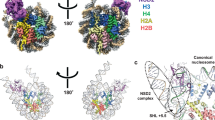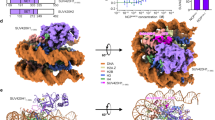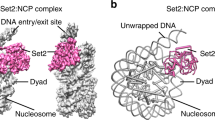Abstract
Histone methyltransferases of the nuclear receptor-binding SET domain protein (NSD) family, including NSD1, NSD2 and NSD3, have crucial roles in chromatin regulation and are implicated in oncogenesis1,2. NSD enzymes exhibit an autoinhibitory state that is relieved by binding to nucleosomes, enabling dimethylation of histone H3 at Lys36 (H3K36)3,4,5,6,7. However, the molecular basis that underlies this mechanism is largely unknown. Here we solve the cryo-electron microscopy structures of NSD2 and NSD3 bound to mononucleosomes. We find that binding of NSD2 and NSD3 to mononucleosomes causes DNA near the linker region to unwrap, which facilitates insertion of the catalytic core between the histone octamer and the unwrapped segment of DNA. A network of DNA- and histone-specific contacts between NSD2 or NSD3 and the nucleosome precisely defines the position of the enzyme on the nucleosome, explaining the specificity of methylation to H3K36. Intermolecular contacts between NSD proteins and nucleosomes are altered by several recurrent cancer-associated mutations in NSD2 and NSD3. NSDs that contain these mutations are catalytically hyperactive in vitro and in cells, and their ectopic expression promotes the proliferation of cancer cells and the growth of xenograft tumours. Together, our research provides molecular insights into the nucleosome-based recognition and histone-modification mechanisms of NSD2 and NSD3, which could lead to strategies for therapeutic targeting of proteins of the NSD family.
This is a preview of subscription content, access via your institution
Access options
Access Nature and 54 other Nature Portfolio journals
Get Nature+, our best-value online-access subscription
$29.99 / 30 days
cancel any time
Subscribe to this journal
Receive 51 print issues and online access
$199.00 per year
only $3.90 per issue
Buy this article
- Purchase on Springer Link
- Instant access to full article PDF
Prices may be subject to local taxes which are calculated during checkout




Similar content being viewed by others
Data availability
The electron microscopy density maps have been deposited in the Electron Microscopy Data Bank (EMDB) with accession codes EMDB-30453, EMDB-30454, EMDB-30455, EMDB-30456 and EMDB-30457. The final models were submitted to the RCSB PDB with accession codes 7CRO, 7CRP, 7CRQ and 7CRR. Other PDB codes used in this study, including 1AOI, 3MVD, 3OOI and 5UPD, can also be accessed through their respective accession codes in the PDB. Data relating to the E1099K and T1150A mutations in NSD2 and the T1232A mutation in NSD3 can be accessed through the COSMIC database (http://cancer.sanger.ac.uk) under the genomic mutation identifiers COSV56386422, COSV56385908 and COSV57670291, respectively. Gel source data are provided as Supplementary Fig. 1 for cropped images shown in Figs. 1e, 3c, 4a, c, e and Extended Data Figs. 3a, 7a, c, d. Source data are provided with this paper.
References
Husmann, D. & Gozani, O. Histone lysine methyltransferases in biology and disease. Nat. Struct. Mol. Biol. 26, 880–889 (2019).
Bennett, R. L., Swaroop, A., Troche, C. & Licht, J. D. The role of nuclear receptor-binding set domain family histone lysine methyltransferases in cancer. Cold Spring Harb. Perspect. Med. 7, a026708 (2017).
Kuo, A. J. et al. NSD2 links dimethylation of histone H3 at lysine 36 to oncogenic programming. Mol. Cell 44, 609–620 (2011).
Li, Y. et al. The target of the NSD family of histone lysine methyltransferases depends on the nature of the substrate. J. Biol. Chem. 284, 34283–34295 (2009).
Morrison, M. J. et al. Identification of a peptide inhibitor for the histone methyltransferase WHSC1. PLoS ONE 13, e0197082 (2018).
Qiao, Q. et al. The structure of NSD1 reveals an autoregulatory mechanism underlying histone H3K36 methylation. J. Biol. Chem. 286, 8361–8368 (2011).
Tisi, D. et al. Structure of the epigenetic oncogene MMSET and inhibition by N-alkyl sinefungin derivatives. ACS Chem. Biol. 11, 3093–3105 (2016).
Ding, L. W. et al. Mutational landscape of pediatric acute lymphoblastic leukemia. Cancer Res. 77, 390–400 (2017).
Jaffe, J. D. et al. Global chromatin profiling reveals NSD2 mutations in pediatric acute lymphoblastic leukemia. Nat. Genet. 45, 1386–1391 (2013).
Oyer, J. A. et al. Point mutation E1099K in MMSET/NSD2 enhances its methyltranferase activity and leads to altered global chromatin methylation in lymphoid malignancies. Leukemia 28, 198–201 (2014).
Swaroop, A. et al. An activating mutation of the NSD2 histone methyltransferase drives oncogenic reprogramming in acute lymphocytic leukemia. Oncogene 38, 671–686 (2019).
Tate, J. G. et al. COSMIC: the catalogue of somatic mutations in cancer. Nucleic Acids Res. 47, D941–D947 (2019).
van Hest, J. C. M., Kiick, K. L. & Tirrell, D. A. Efficient incorporation of unsaturated methionine analogues into proteins in vivo. J. Am. Chem. Soc. 122, 1282–1288 (2000).
Worden, E. J., Hoffmann, N. A., Hicks, C. W. & Wolberger, C. Mechanism of cross-talk between H2B ubiquitination and H3 methylation by Dot1L. Cell 176, 1490–1501 (2019).
Bilokapic, S. & Halic, M. Nucleosome and ubiquitin position Set2 to methylate H3K36. Nat. Commun. 10, 3795 (2019).
Luger, K., Mäder, A. W., Richmond, R. K., Sargent, D. F. & Richmond, T. J. Crystal structure of the nucleosome core particle at 2.8 A resolution. Nature 389, 251–260 (1997).
Makde, R. D., England, J. R., Yennawar, H. P. & Tan, S. Structure of RCC1 chromatin factor bound to the nucleosome core particle. Nature 467, 562–566 (2010).
Yuan, G. et al. Histone H2A ubiquitination inhibits the enzymatic activity of H3 lysine 36 methyltransferases. J. Biol. Chem. 288, 30832–30842 (2013).
Worden, E. J. & Wolberger, C. Activation and regulation of H2B-ubiquitin-dependent histone methyltransferases. Curr. Opin. Struct. Biol. 59, 98–106 (2019).
He, C., Li, F., Zhang, J., Wu, J. & Shi, Y. The methyltransferase NSD3 has chromatin-binding motifs, PHD5-C5HCH, that are distinct from other NSD (nuclear receptor SET domain) family members in their histone H3 recognition. J. Biol. Chem. 288, 4692–4703 (2013).
Beà, S. et al. Landscape of somatic mutations and clonal evolution in mantle cell lymphoma. Proc. Natl Acad. Sci. USA 110, 18250–18255 (2013).
Landau, D. A. et al. Evolution and impact of subclonal mutations in chronic lymphocytic leukemia. Cell 152, 714–726 (2013).
The Cancer Genome Atlas Network. Comprehensive genomic characterization of head and neck squamous cell carcinomas. Nature 517, 576–582 (2015).
Coussens, N. P. et al. High-throughput screening with nucleosome substrate identifies small-molecule inhibitors of the human histone lysine methyltransferase NSD2. J. Biol. Chem. 293, 13750–13765 (2018).
Drake, K. M., Watson, V. G., Kisielewski, A., Glynn, R. & Napper, A. D. A sensitive luminescent assay for the histone methyltransferase NSD1 and other SAM-dependent enzymes. Assay Drug Dev. Technol. 12, 258–271 (2014).
Shen, Y. et al. Identification of LEM-14 inhibitor of the oncoprotein NSD2. Biochem. Biophys. Res. Commun. 508, 102–108 (2019).
Dyer, P. N. et al. Reconstitution of nucleosome core particles from recombinant histones and DNA. Methods Enzymol. 375, 23–44 (2003).
Luger, K., Rechsteiner, T. J. & Richmond, T. J. Preparation of nucleosome core particle from recombinant histones. Meth. Enzymol. 304, 3–19 (1999).
Lowary, P. T. & Widom, J. New DNA sequence rules for high affinity binding to histone octamer and sequence-directed nucleosome positioning. J. Mol. Biol. 276, 19–42 (1998).
Song, F. et al. Cryo-EM study of the chromatin fiber reveals a double helix twisted by tetranucleosomal units. Science 344, 376–380 (2014).
Liu, S. et al. METTL13 methylation of eEF1A increases translational output to promote tumorigenesis. Cell 176, 491–504 (2019).
Xue, H. et al. Structural basis of nucleosome recognition and modification by MLL methyltransferases. Nature 573, 445–449 (2019).
Zheng, S. Q. et al. MotionCor2: anisotropic correction of beam-induced motion for improved cryo-electron microscopy. Nat. Methods 14, 331–332 (2017).
Zhang, K. Gctf: real-time CTF determination and correction. J. Struct. Biol. 193, 1–12 (2016).
Kimanius, D., Forsberg, B. O., Scheres, S. H. W. & Lindahl, E. Accelerated cryo-EM structure determination with parallelisation using GPUs in RELION-2. eLife 5, e18722 (2016).
Scheres, S. H. W. A Bayesian view on cryo-EM structure determination. J. Mol. Biol. 415, 406–418 (2012).
Kucukelbir, A., Sigworth, F. J. & Tagare, H. D. Quantifying the local resolution of cryo-EM density maps. Nat. Methods 11, 63–65 (2014).
Pettersen, E. F. et al. UCSF Chimera—a visualization system for exploratory research and analysis. J. Comput. Chem. 25, 1605–1612 (2004).
Emsley, P., Lohkamp, B., Scott, W. G. & Cowtan, K. Features and development of Coot. Acta Crystallogr. D 66, 486–501 (2010).
Adams, P. D. et al. PHENIX: a comprehensive Python-based system for macromolecular structure solution. Acta Crystallogr. D 66, 213–221 (2010).
Chen, V. B. et al. MolProbity: all-atom structure validation for macromolecular crystallography. Acta Crystallogr. D 66, 12–21 (2010).
Acknowledgements
We thank the cryo-EM centre of the Southern University of Science and Technology (SUSTech) and the National Centre for Protein Science Shanghai (NCPSS) for supporting cryo-EM data collection and analysis; G. Li for providing histone-expressing plasmids; and X. Gong and N. Gao for support with cryo-EM studies. This work was supported by the National Natural Science Foundation of China (31870725 and 31570729) and the Fundamental Research Funds for the Central Universities (2017EYT19) to Z.W.; a Leukemia & Lymphoma Society grant and support from a Memorial Sloan Kettering Cancer Center core grant (P30CA008748) to D.J.P.; a SUSTech Presidential Postdoctoral Fellowship and a Basic Research grant from the Shenzhen government (JCYJ20180302174213122) to W.L.; and a grant from the NIH (R01GM079641) to O.G. D.S. was supported by a grant from Stanford Maternal and Child Health Research Institute. Research at SUSTech was supported by the Office of the President.
Author information
Authors and Affiliations
Contributions
W.L. performed cryo-EM data collection, processing and model building in consultation with D.J.P.; W.T. and P.D. reconstituted the complexes, performed biochemical analysis and prepared the cryo-EM samples under the supervision of Z.W.; G.Y. performed biochemical analysis; G.Y. and D.S. performed all the cell-based and xenograft experiments under the supervision of O.G.; Z.C. did early research relating to the reconstitution of the NSD2–NCP complex in the D.J.P. laboratory; and Y.C., J.R., Y.Q., Y.Z. and Y.J. helped in protein purification and nucleosome reconstitution. Z.W. initialized the project and took a leadership and coordination role in the collaborative design and execution of experiments, as well as in writing the paper with O.G. and D.J.P.
Corresponding authors
Ethics declarations
Competing interests
O.G. is a co-founder of Epicypher and Athelas Therapeutics. The remaining authors declare no competing interests.
Additional information
Peer review information Nature thanks Cigall Kadoch, Hitoshi Kurumizaka and Jonathan Licht for their contribution to the peer review of this work.
Publisher’s note Springer Nature remains neutral with regard to jurisdictional claims in published maps and institutional affiliations.
Extended data figures and tables
Extended Data Fig. 1 Cryo-EM structural analysis of wild-type NSD3C in complex with 187-bp NCPs.
a, Representative cryo-EM micrograph from a total of 2,511 micrographs of the NSD3C–NCP complex (low-pass-filtered to 20 Å). Scale bar, 100 nm. b, Selected 2D class averages of the NSD3C–NCP complex. Scale bar, 10 nm. Box size 216, pixel size 1.08 Å. c, Workflow of the image processing procedures for the NSD3C–NCP complex. It includes several rounds of 2D and 3D classification, refinement and masked refinement. The linker DNA is highly flexible, thus, it is invisible when the density map is shown in high resolution. d, Local-resolution map of the NSD3C–NCP complex final density map. e, FSC curve of the NSD3C–NCP complex final density map.
Extended Data Fig. 2 Cryo-EM structural analysis of NSD3C(E1181K/T1232A) in complex with 187-bp NCPs.
a, Representative cryo-EM micrograph from a total of 3,625 micrographs of the NSD3C(E1181K/T1232A)–NCP complex (low-pass-filtered to 20 Å). Scale bar, 100 nm. b, Selected 2D class averages. Scale bar, 10 nm, box size 108, pixel size 2.16 Å. c, Workflow of the image processing procedures for the NSD3C(E1181K/T1232A)–NCP. It includes several rounds of 2D and 3D classification, refinement and masked refinement. As the linker DNA is highly flexible, it is invisible when the density map is shown at a high contour level. d, FSC curves of the NSD3C(E1181K/T1232A)–NCP complex in different binding states. e, Local-resolution map of the 1:2 (NCP:NSD3 ratio) NSD3C(E1181K/T1232A)–NCP complex final density map. f, Local-resolution map of the 1:1 NSD3C(E1181K/T1232A)–NCP complex final density map. g–i, Local-density map of representative regions of the final cryo-EM density map, for the H3 tail (g), NSD3 AWS domain (h) and NSD3 SET domain (i).
Extended Data Fig. 3 EMSA and structural analysis of NSD3C in complex with 187-bp NCPs.
a, EMSA analysis of NSD3C with native or Nle-labelled 187-bp NCPs. The concentrations of added NSD3C are indicated above the lanes. The results were repeated in at least three independent experiments. For gel source data, see Supplementary Fig. 1. b, Superimposition of the 1:1 NSD3C–NCP complex with an apo NCP (PDB code 1AOI). Histone proteins and the wrapped DNA in the apo NCP are coloured in yellow and blue, respectively. Histone proteins and the nucleosomal DNA in the NSD3C-binding NCP are coloured in grey and orange, respectively. NSD3C is coloured in green. c, Top (left) and side (right) views of the sharpened cryo-EM density map of the 1:2 (NCP:NSD3 ratio) NSD3C(E1181K/T1232A)–NCP complex (contoured at 3σ). NSD3C(E1181K/T1232A) is coloured in green. NCP DNA and histone proteins are coloured in orange and grey, respectively. d, Top (left) and side (right) views of the inactive state of the NSD3C–NCP complex. The 146-bp NCP structure (PDB code 1AOI) was docked into the density of the 187-bp NCP. The cryo-EM density map is coloured in grey and contoured at 1.5σ. Additional densities that lie on the top of the nucleosome disk are densities of NSD3C.
Extended Data Fig. 4 MST-based analysis of wild-type and mutant NSD3C in complex with 187-bp NCPs.
Left, MST binding curves of wild-type NSD3C and NSD3C mutants with 187-bp NCPs. Right, dissociation constants (Kd) derived from the left curves. Data are represented as mean ± s.d. from n = 3 biologically independent samples.
Extended Data Fig. 5 Cryo-EM structural analysis of NSD2C(E1099K/T1150A) in complex with 187-bp NCPs.
a, Representative cryo-EM micrograph from a total of 1,388 micrographs of the NSD2C(E1099K/T1150A)–NCP complex (low-pass-filtered to 20 Å). Scale bar, 100 nm. b, Selected 2D class averages. Scale bar, 10 nm, box size 216, pixel size 1.08 Å. c, Workflow of the image processing procedures for the NSD2C(E1099K/T1150A)–NCP complex. d, Local-resolution map of the NSD2C(E1099K/T1150A)–NCP complex final density map. e, FSC curve of the NSD2C(E1099K/T1150A)–NCP complex.
Extended Data Fig. 6 Glu1181 and Thr1232 sites of NSD3 in the structure of the NSD3C(E1181K/T1232A)–NCP complex.
a, Comparisons of the structural differences between the superimposed NCP-bound wild-type NSD3C (grey) and E1181K/T1232A-mutated (coloured as described above) NSD3C. b, The side chain of Thr1232 in wild-type NSD3C is inserted into a hydrophobic pocket composed of hydrophobic residues from both NSD3C and histone H3.
Extended Data Fig. 7 Proliferation of UD-SCC-2 cells is dependent on NSD3.
a, Western blot analysis with indicated antibodies of whole-cell lysates from wild-type or NSD3-depleted UD-SCC-2 cells as indicated. All data were reproduced in three independent experiments. b, Cell proliferation rates of UD-SCC-2 cells expressing CRISPR–Cas9 and two independent NSD3 sgRNAs or a control sgRNA. Data are represented as mean ± s.d. from n = 3 biologically independent samples. **P < 0.01, n.s., not significant, two-tailed unpaired Student’s t-test. Cell lines were numbered as follows: (1) sgControl, (2) sgNSD3-1, (3) sgNSD3-2. P values between the cells are as follows: P (1 versus 2) = 0.0046, P (1 versus 3) = 0.0029, P (2 versus 3) = 0.3249. c, Western blot analysis of NSD3-depleted UD-SCC-2 cells complemented with structure-guided NSD3 derivatives. All data were reproduced in three independent experiments. d, Validation of NSD3 antibody specificity. Left, transient expression of either vector alone or Flag-tagged NSD3 in HEK 293T cells. Right, CRISPR–Cas9-mediated knockdown of either control or NSD3 in MDA-MB-231 cells. Whole-cell lysates were blotted with indicated antibodies. *, non-specific band. All data were reproduced in three independent experiments. For gel source data, see Supplementary Fig. 1.
Supplementary information
Supplementary Figure
This file includes Supplementary Figure 1. Uncropped blot or EMSA images for Figs. 1e, 3c, 4a, 4c, 4e, and Extended Data Figs. 3a, 7a, 7c and 7d. Control Tubulin samples in Figs. 4a, 4c, 4e and Extended Data Figs. 7a, 7c and 7d were run on the same gels as the loading controls.
Source data
Rights and permissions
About this article
Cite this article
Li, W., Tian, W., Yuan, G. et al. Molecular basis of nucleosomal H3K36 methylation by NSD methyltransferases. Nature 590, 498–503 (2021). https://doi.org/10.1038/s41586-020-03069-8
Received:
Accepted:
Published:
Issue Date:
DOI: https://doi.org/10.1038/s41586-020-03069-8
This article is cited by
-
Dysregulation of histone modifications in bone marrow mesenchymal stem cells during skeletal ageing: roles and therapeutic prospects
Stem Cell Research & Therapy (2023)
-
Structural basis of nucleosomal H4K20 recognition and methylation by SUV420H1 methyltransferase
Cell Discovery (2023)
-
Structural basis of paralog-specific KDM2A/B nucleosome recognition
Nature Chemical Biology (2023)
-
Structural and functional specificity of H3K36 methylation
Epigenetics & Chromatin (2022)
-
NSD1 gene evolves under episodic selection within primates and mutations of specific exons in humans cause Sotos syndrome
BMC Genomics (2022)
Comments
By submitting a comment you agree to abide by our Terms and Community Guidelines. If you find something abusive or that does not comply with our terms or guidelines please flag it as inappropriate.



